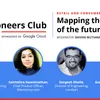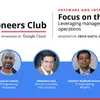The pandemic affected almost every industry and business function, resulting in short-term pivots and a shift in priorities for many. For others, it validated their offerings. Conversations with industry leaders reveal that organisations that coped better to the fast-changing external environment brought about by the COVID-19 pandemic were those that leveraged technology to shape solutions for the new normal.
The latest edition of the Digital Pioneers Club CTO Roundtable series, hosted in association with Google Cloud brought to the fore these stories of resilience and innovation. Leading the conversations were Manish Mittal, Managing Principal - India, Axtria; Jayateerth Mirji, VP Technology, TeamLease; Vijay Sivaram, CEO, Quess IT Staffing, Quess Corp; Mani Rangarajan, Group COO, PropTiger and Mitesh Agarwal, Head of Customer Engineering, Google Cloud India.
Evolution of business models
The weeks that followed after the onset of the pandemic saw businesses creating new opportunities by bringing about an acceleration in adopting new business models. For instance, real estate advisory PropTiger launched a virtual platform ‘PropTiger Direct’ where customers could experience digital home-buying. It provided access to multiple projects in different localities of a city, access to digital brochures, project and locality videos, pre-recorded webinars with experts from the area, virtual site tours and complete coverage of site location and locality through drone shoots. Mani points out that there were a lot of naysayers about real estate at the start of the pandemic, however contrary to the market expectations the sector witnessed a resurgence in consumer interest aided by adoption of remote working, hybrid working and the fact that people felt safest in their ‘own homes’. In addition, the sector saw the entire ecosystem of realty developers, brokers, house owners, and consumers coming forward to embrace digitisation. “We saw a massive change in people's outlook towards digitisation,” he said.
Quess Corp, a leading business services provider — offering services like workforce management, asset management among others, to 2,600+ customers across 10 countries — reimagined three pivotal requirements of organisations the pandemic had displaced - people, productivity and technology. “We needed to figure out how people could work in different formats - be it work from home, hybrid or back to office. We also had to ensure that there are systems in place for employees to stay productive and build metrics that could define productivity under the new circumstances. From a technology perspective, we needed structural infrastructure that could ensure smooth day-to-day operations. So, we needed to make sure that people, productivity and technology are in place at all times and keep improving,” shared Vijay.
Counted among one of India’s leading human resource companies, TeamLease Services saw an acceleration in transforming from a technology-enabled company to becoming a technology-driven company. “Services like hiring, onboarding, employee cycle management, financial reconciliation, etc which are enabled by technology are at the core of our business. In addition, we also have SaaS products like Digital Workforce Solutions that addresses some of the most critical challenges faced in workforce management. In the last one year, we saw an increase in the adoption of technologies which in turn brought in an extensive acceleration in the evolution of our technology offerings with new capabilities and features,” shared Jayateerth.
Using technology to gain from customer insights
“At Google and Google Could, the way we have worked with organisations in the past is phenomenally different from the last 18 months,” shared Mitesh. He underlined that Google’s work with organisations have traditionally focused on three broad areas. First, how Google can help in an organisation’s cultural transformation while embracing technology. Second, how to enable business build scale, security and resilience by enabling access to the same set of technologies irrespective of the size of the business. “Here, Google Cloud has been a big lever in terms of democratising access to technologies,” he said. Third, how to enable organisations to make better data-driven discussions.
He shared, “Bringing all the three together - organisational and cultural transformation, access to best-in-class technology and data-driven decision-making together create a very powerful condition and that unleashes innovation and transformation. And, this is what we've been doing with a number of customers across the globe including India.” Mitesh highlighted Google Cloud’s recent partnership with Indian telecommunications giant Reliance Jio Infocomm to build solutions in 5G for the enterprise and consumer segments as an example in the direction. “In a very short period of time, India will have its first 5G phone, powered by Google Cloud.”
From hosting applications on the cloud to hosting data on the cloud
“Data Warehousing has been around for a long long time. But what has really changed in the last couple of years has been the journey of data to the cloud,” shared Manish of Axtria, a global provider of cloud software and data analytics to the life sciences industry. Manish highlighted that cloud providers like Google Cloud and others in the industry today provide security and privacy, which are critical for enterprises.
In addition, privacy regulations such as The Health Insurance Portability and Accountability Act (HIPAA), the US federal law that requires the creation of national standards to protect sensitive patient health information and the General Data Protection Regulation 2016/679 (GDPR), the European Union law on data protection and privacy have further built the consumer and industry confidence. “This has enabled enterprises to get comfortable with taking data to the cloud, building their data lakes, data warehouses, etc. and make way for structured and unstructured data to be made available to business owners without having to deep-dive into the tech stack. And, this has accelerated in the last 18 months. Five years ago, enterprises were only talking about applications and cloud, but they are now looking at hosting data on the cloud. It is no longer a question mark anymore.”
It’s raining clouds: The power of multi-cloud environments
Mitesh highlighted that various definitions of multi-cloud environments exist and are often accurate given the context, “most organisations when they look at multi-cloud, they're looking at it for growth.” Here, he pointed out how Google Cloud’s Anthos is an innovative product that becomes a model platform for both hybrid and multi-cloud environments. Anthos unifies the management of infrastructure and applications across on-premises, edge, and in multiple public clouds with a Google Cloud-backed control plane for consistent operation at scale. “We released Google Cloud Anthos a couple of years back and have built some fantastic use cases. We have organisations in banking, telecom manufacturing, and life sciences that have really started using this. Anthos enables organisations to freely choose where they want to deploy and provide them the ability to manage it in a unified way,” he said.
He predicted that 90 percent of the enterprises globally will move towards a multi-cloud strategy, making Anthos highly relevant for the market. “With Anthos customers get the freedom of choice to chart their own cloud as well as transformation journey. In addition, Anthos also provides the capability to run BigQuery on multi-cloud.”
Building tech products using customer habits
The discussion also highlighted how startups can build new tech products by keeping the needs of the business and customer at its core. PropTiger’s Mani shared, “We are a proptech company, and we have technology firmly in our DNA. As a tech-driven company we have realised that you should not build a technology which requires a market, instead you need to focus on the market and understand the kind of technology solutions that fit in.” He shared an example of how at Housing.com they saw an opportunity to increase the customer engagement level on the platform via digitisation in the early days of the pandemic. “Unlike e-commerce marketplaces which have a high level of engagement, customers visit property portals like Housing.com only when they want to buy, rent or sell a house. We realised there are a lot of periphery activities around buying, renting or selling that open up opportunities to engage with the customer,” he explained.
This observation led PropTiger to launch ‘Housing Edge’- a full-stack rental and allied services platform, through which the company enabled digitisation of multiple services that tenants and landlords can avail. These services include packages like online rent payment, rental agreements, tenant verification, packing and moving, furniture rental, home interiors, and home services. “The move has led to an exceptional increase in engagement because of the product-market fit. Today, the platform sees about 300,000 transactions being done every month with a high repeat usage rate. About 80 percent of people who come to pay rent on the platform tend to use the product every month,” he explained.
The discussion also saw the panelists sharing the technologies they have used extensively to build and strengthen their product offerings and the impact it has had on their growth and digitisation journey.
Link : https://yourstory.com/2021/08/developing-tech-driven-solutions-cxos-experiences
Author :- Team YS ( )
August 25, 2021 at 04:38PM
YourStory


